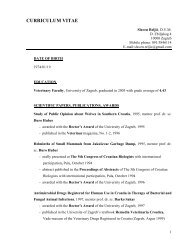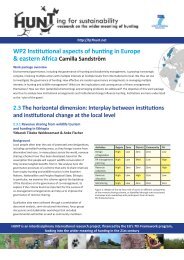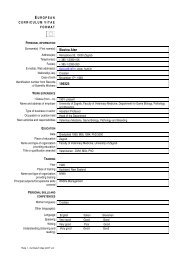XXXth - Hunting for sustainability
XXXth - Hunting for sustainability
XXXth - Hunting for sustainability
You also want an ePaper? Increase the reach of your titles
YUMPU automatically turns print PDFs into web optimized ePapers that Google loves.
XXX thIUGB CONGRESS(International Union of Game Biologist)AND PERDIX XIII5 th -9 th September 2011
”SUSTAINABLE HUNTING”:AN EXPLORATION ALONG ECOLOGICAL AND SOCIAL DIMENSIONSJohn D. C. LinnellNorwegian Institute <strong>for</strong> Nature Research, Trondheim, Norway.john.linnell@nina.no<strong>Hunting</strong> is one of the oldest activities that Europeans have conducted, but what role does ithave in the 21 st century? One hand hunting is a very controversial activity, because of the (1)fact that it by definition involves the death of animals and (2) the social context in which itoccurs, and (3) the institutional manner in which it is organized. On the other hand, huntingis also per<strong>for</strong>ms an important social and cultural function in many rural communities.Likewise, although many <strong>for</strong>ms of hunting may represent a blueprint <strong>for</strong> the ecologicallysustainable use of natural resources, which is sorely needed when we look at the globalbiodiversity crisis, there are other <strong>for</strong>ms that may well be responsible <strong>for</strong> population declinesof target species. The project “<strong>Hunting</strong> <strong>for</strong> Sustainability” (funded by the EU’s FP7 program)simultaneously examines the social and ecological dimensions of hunting in the modernworld through a selection of case studies scattered across Scandinavia, Scotland, Spain, theBalkans and Africa. This diversity of studies has provided unique insights into the diversity ofissues that influence the <strong>sustainability</strong> of hunting, and even to the way in which we define<strong>sustainability</strong>. This talk will present some reflections resulting from this project’s activitiesconcerning the way in which social dimensions need to be integrated into considerations ofecological dimensions with respect to <strong>for</strong>mulating hunting related policy.33
MANAGING CONFLICTS BETWEEN CONSERVATION AND GAMEBIRD MANAGEMENTSteve RedpathUniversity of Aberdeens.redpath@abdn.ac.ukAcross Europe, gamebird hunting is an important <strong>for</strong>m of land use with a long history andrich traditions. The way gamebird hunting is managed varies considerably between differentregions, especially in relation to the types of management and levels of managementintensity. <strong>Hunting</strong> and its associated practices provides important benefits to biodiversity,but it also finds itself in conflict with conservation in some regions. In particular the illegalcontrol of predators that is associated with gamebird hunting in some countries bringshunters into direct conflict with conservation organisations. In this talk I will explore theevidence <strong>for</strong> the costs and benefits of hunting <strong>for</strong> biodiversity, and then focus on thechallenges of dealing with conflicts over illegal predator control. Throughout, I will drawon one conflict I have studied <strong>for</strong> nearly 25 years involving birds of prey and red grousein the UK uplands, considering the causes of this fascinating and revealing conflict, thevariety of alternative solutions that have been proposed, the barriers that have preventedresolution and the approach currently employed to resolve the conflict. I will explore therole of science, legislation and dialogue and consider the ways <strong>for</strong>ward in finding a solutionto this problem. I will end by considering the broader lessons <strong>for</strong> gamebird management.36
PREDATOR CONTROL IN SMALL GAME ESTATES IN CENTRAL SPAIN:PRACTICES AND PERCEPTIONSMiguel Delibes-Mateos, Beatriz Arroyo, Silvia Díaz-Fernández and Javier ViñuelaInstituto de Investigación en Recursos Cinegéticos (IREC-CSIC-UCLM-JCCM). Ronda de Toledos/n, 13071, Ciudad Real (Spain).Miguel.Delibes@uclm.esHuman-wildlife conflicts are widespread and socially important where predators areinvolved. Predator species may compete with us <strong>for</strong> the same resources (e.g. game species)and predator control <strong>for</strong> hunting purposes is thus frequently implemented in many countries.In spite of this, many aspects regarding predator control are still unknown. We aimed toevaluate quantitatively the extent and methods of predator control implemented in centralSpain, and assess the reasons that lead game managers to control predators. In addition, weinvestigated whether practices and perceptions regarding predator control vary accordingto the type of hunting estate (commercial or non-commercial). Data were gathered throughface to face interviews with game managers from 58 small-game hunting estates withincentral Spain. Predator control was employed in 90 % of the estates, and control intensityincreased in commercial estates, which invest more money on gamekeepers.The main methods employed were cage-traps, shooting and destruction of warrens andnests. Some illegal practices (e.g. leg-hold traps) were also admittedly used. Overall, nonselectivemethods, such as snares, were more frequently employed in commercial estates.Most managers believed that predators had an important effect on prey, and there<strong>for</strong>e thatnot doing it would lead to smaller hunting bags. This argument did not vary among differenttypes of hunting estates. Predator control intensity was directly related to the perceptionof its need by the managers. Our results highlight the important role that both social andeconomic factors (i.e. perceptions and types of estates, respectively) play driving predatorcontrol, and there<strong>for</strong>e the need of incorporating these factors when making decisions tomitigate the human-predator conflict.73
Kerezi, V. 1 and A. Bath 2THE MEANINGS OF HUNTING IN GORSKI KOTAR, CROATIA1. MA candidate, Memorial University of Newfoundland; Biology Department, Faculty ofVeterinary Medicine, University of Zagreb, Heinzelova 55, 10000 Zagreb, Croatia.vesna.kerezi@gmail.com2. Associate Professor, Department of Geography, Memorial University of Newfoundland;St. John’s, NL A1B 3X9.abath@mun.caHuman dimensions research on hunting predominantly focuses on the socio-economics ofhunting and less focus is given to the cultural and social context of the activity. This studyinvestigated the cultural and social aspects of hunting in the region of Gorski kotar (Croatia)by exploring meanings and perceptions of hunting to hunters and non-hunters. Specifically,this research examined the reasons and motivations that drive people to hunt, their opinionson hunting, and the role that hunting plays in their life.Semi-structured in-depth interviews (n = 7) and focus groups (n = 5) were conducted withhunters and non-hunters. Data were analyzed using a grounded theory approach. Thefindings suggested that both hunters and non-hunters perceived hunting as a traditionalactivity, and recognized it as an element of future regional development. Differentmotivations <strong>for</strong> hunting were identified (e.g. recreation, stress relief, trophy). Both groupsevaluated hunting depending on the perceived motivations behind participation and thetypes of hunting. Non-hunters considered hunting as beneficial to the community (i.e.economic income), whereas hunters benefits were more personal (i.e., companionship).Hunters indicated a greater number of limiting factors <strong>for</strong> the future growth of huntingthan non-hunters. This study provided a better understanding of the importance of huntingand its relationship with game management. The results of this research can be used topromote hunting activities and provide an understanding of the importance this activity haswithin the local community.62
SUSTAINABILITY OF DIFFERENT MANAGEMENT REGIMES OF THE DINARICBROWN BEAR POPULATION IN SLOVENIA AND CROATIASlaven Reljic 1 , Klemen Jerina 2 , Erlend B. Nilsen 3 , John D.C. Linnell 3 and Djuro Huber 11. Biology Department, Faculty of Veterinary Medicine, University of Zagreb, Heinzelova 55,Zagreb, Croatia.slaven.reljic@gmail.com,2. Department of Forestry and Renewable Forest Resources, Biotechnical Faculty, Universityof Ljubljana, Večna pot 83, Ljubljana, Slovenia.3. The Norwegian Institute <strong>for</strong> Nature Research (NINA), Tungasletta 2, Trondheim, Norway.Slovenia and Croatia share the same brown bear population. The species is <strong>for</strong>mally strictlyprotected with culling regulated through “derogations” in Slovenia while in Croatia it isstill managed as a game species. The aim of our study was to gain insight into the long-term<strong>sustainability</strong> of different management regimes. We used bear mortality data <strong>for</strong> Sloveniafrom 1998 to 2008 (n = 922) and <strong>for</strong> Croatia from 2005 to 2009 (n = 422). A two-sampletest <strong>for</strong> equality of proportions indicated that, in the total reported mortality, the shareof animals killed in quota hunting in Slovenia (59,4%) was significantly lower (χ 2 -sq. = 7.1,df = 1, p







